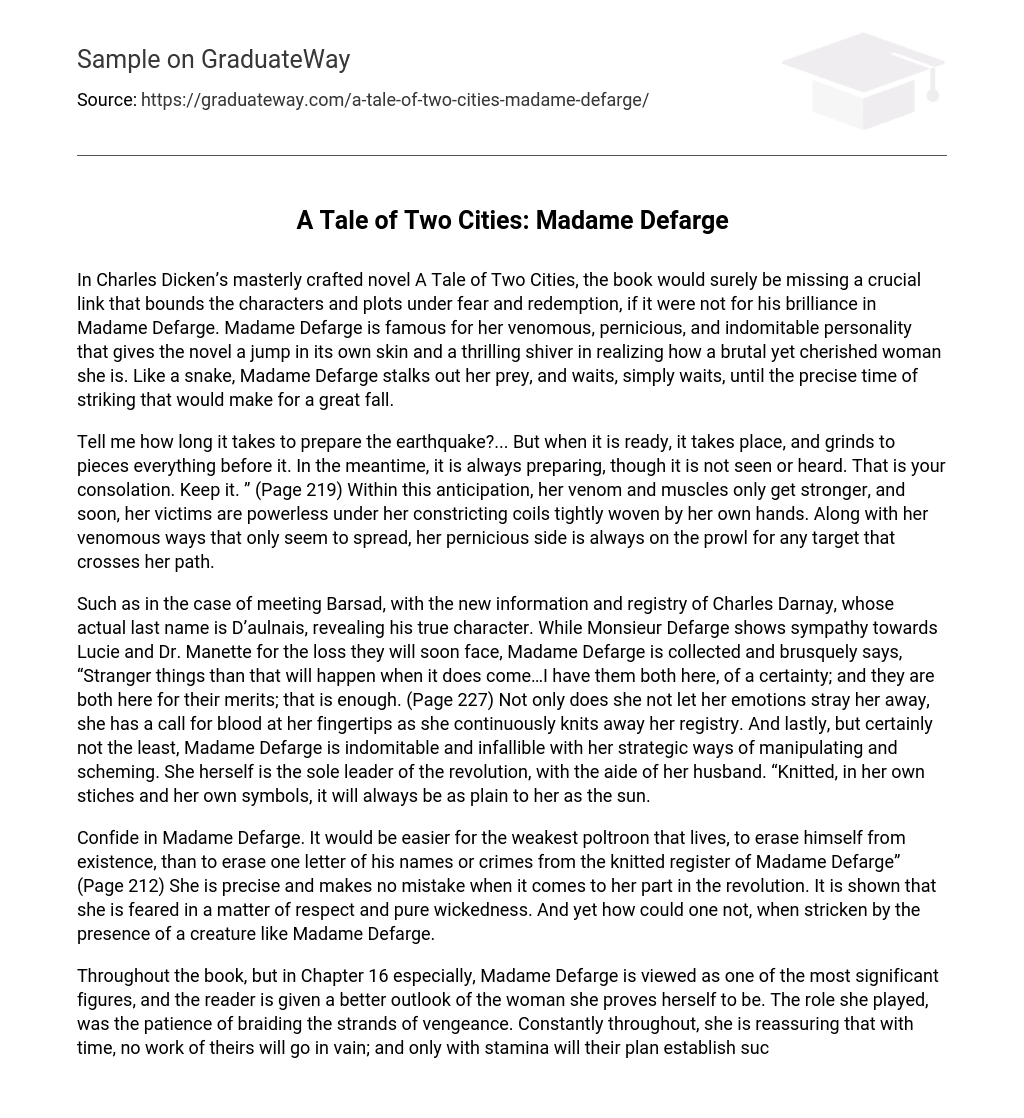In Charles Dicken’s masterly crafted novel A Tale of Two Cities, the book would surely be missing a crucial link that bounds the characters and plots under fear and redemption, if it were not for his brilliance in Madame Defarge. Madame Defarge is famous for her venomous, pernicious, and indomitable personality that gives the novel a jump in its own skin and a thrilling shiver in realizing how a brutal yet cherished woman she is. Like a snake, Madame Defarge stalks out her prey, and waits, simply waits, until the precise time of striking that would make for a great fall.
Tell me how long it takes to prepare the earthquake?… But when it is ready, it takes place, and grinds to pieces everything before it. In the meantime, it is always preparing, though it is not seen or heard. That is your consolation. Keep it. ” (Page 219) Within this anticipation, her venom and muscles only get stronger, and soon, her victims are powerless under her constricting coils tightly woven by her own hands. Along with her venomous ways that only seem to spread, her pernicious side is always on the prowl for any target that crosses her path.
Such as in the case of meeting Barsad, with the new information and registry of Charles Darnay, whose actual last name is D’aulnais, revealing his true character. While Monsieur Defarge shows sympathy towards Lucie and Dr. Manette for the loss they will soon face, Madame Defarge is collected and brusquely says, “Stranger things than that will happen when it does come…I have them both here, of a certainty; and they are both here for their merits; that is enough. (Page 227) Not only does she not let her emotions stray her away, she has a call for blood at her fingertips as she continuously knits away her registry. And lastly, but certainly not the least, Madame Defarge is indomitable and infallible with her strategic ways of manipulating and scheming. She herself is the sole leader of the revolution, with the aide of her husband. “Knitted, in her own stiches and her own symbols, it will always be as plain to her as the sun.
Confide in Madame Defarge. It would be easier for the weakest poltroon that lives, to erase himself from existence, than to erase one letter of his names or crimes from the knitted register of Madame Defarge” (Page 212) She is precise and makes no mistake when it comes to her part in the revolution. It is shown that she is feared in a matter of respect and pure wickedness. And yet how could one not, when stricken by the presence of a creature like Madame Defarge.
Throughout the book, but in Chapter 16 especially, Madame Defarge is viewed as one of the most significant figures, and the reader is given a better outlook of the woman she proves herself to be. The role she played, was the patience of braiding the strands of vengeance. Constantly throughout, she is reassuring that with time, no work of theirs will go in vain; and only with stamina will their plan establish success. She is able to see things and hear things from a distance and apply it somehow in some premonition to the revolution.
The quote, “Darkness closed around, and then came the ringing of church bells and the distant beating of the military drums in the Palace Courtyard, as the women sat knitting, knitting. ” (Page 228) displays the omniscient yet high tensioned atmosphere of the chapter. It is also very particular about the importance of being conscientious and determined through waiting, a main theme throughout the book. It foreshadows directly to the revolution through symbolisms. The mood is automatically shifted as soon as it mentions darkness, since nature is very correlated with when something obscure or bright is on the horizon.
The ringing of the church bells and military drums in the Palace Courtyard is their metronome that sets up the rhythm and composition of how and when they can make their grand entrance, in the Storming of the Bastille, the spark of revolution. And lastly, the knitting shows how women sat around counting the dropping heads on their stitches, but also far more than that. The knitting traces back to Greek mythology based on the three sisters named The Fates; where one sister spun the web of life, one measured it, and the last one cut it.
The knitting becomes a symbol of Madame Defarge who weaves in the names of the condemned and indeed holds pools of blood within her hands. Chapter 16 is unquestionably the chapter that leads to the revolution and shows the grand role Madame Defarge executes. Through her venomous, pernicious, and indomitable ways, Madame Defarge is surely the most alarming yet appreciative character that has ever existed in literature. Without her elements she adds to the book, it seems almost impossible to go on. It is in Madame Defarge that holds the future and outcome of how this tale of two cities will finish to be.





